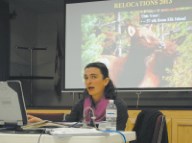As spring and warmer weather approach, bears will begin to leave their dens of hibernation in search of food after their long winter's nap, experts say.
Locals can expect to see the first bears of 2013 any time between now and the middle of April, said wildlife biologist Chiara Feder.
Temperature and light play major roles in bears' hibernation patterns, said Feder, who works with Alberta Environment and Sustainable Resource Development (ESRD).
“It's not just a question of warmer weather, but also the increased amount of light this time of year,” she said. “By now, you can expect the males to be coming out soon.”
Though there haven't been any bear sightings yet in Mountain View County (MVC), it's warm enough that there are bound to be sightings soon, said Paul Fraser, chairman of Mountain View BearSmart.
“It's amazing how many people don't realize how far east bears do come,” said Fraser.
“I live out in Bearberry, and every year, March 21, we have a big male grizzly bear that comes out of his den and walks past our place.
“It's almost like clockwork – he knows when spring is. He comes from a ways out looking for something to eat.”
Though a variety of factors are involved, Feder said male bears tend to exit hibernation earlier than female bears, due to females giving birth in January.
“They're safe, and in a warm place, so they tend to keep their young in the den for a little bit longer to make sure they can find something to eat once they come out.”
“A fundamental variable is how much food – how much fat – they were able to accumulate before heading into the den in the fall. It's a key factor for their survival,” she said.
“At this point, they've used whatever reserves they put away for the hibernation, and they certainly are looking for food.”
When bears leave hibernation they are typically in search of animal carcasses like deer, she said, as the roots, bulbs, berries, and other vegetation bears would typically look for are mostly unfavourable to them at this point.
“The bears prefer to eat them the following year, after they've been frozen, because it concentrates the amounts of sugars in them,” she said.
Members of the public should avoid signs of animal carcasses at this time of year, said Fraser.
“Bears can smell them from a long distance, and come for a winter kill carcass. You want to make sure you stay away from it, and have bear spray with you.”
Fraser also suggests acerage owners and those living on the edge of town should avoid putting out their bird feeders from April through November, because it attracts bears.
“Bears have a keen sense of smell. If there aren't a lot of natural food sources around at this time of year, they will go seek alternate food sources.”
These alternate food sources could be any number of things to a bear – human food, bird feeders, pet food, garbage – all of which could cause a potentially dangerous human–bear encounter, he said.
Pet owners should bring food in from outdoors if they have to feed them outside, and garbage should be stored securely until the morning removal services come to the home for pickup, he said.
“There's lots of instances where people have left garbage in the back of their trucks, and that will draw them in,” said Fraser.
Residents are more likely to see a grizzly bear than a black bear in the late winter and early spring, because black bears are deeper sleepers, says Feder.
“Grizzly bears are much lighter sleepers, and may be able to come in and out of the den.”
This is why there have often been sightings of bear tracks around Christmas and New Year's, she said.
“It's particularly nice and warm on a sunny day. Maybe they'll wake up and go for a stretch, and they go straight back into their dens.”
Recreationalists taking part in backcountry activities like snowshoeing, cross-country skiing, or snowmobiling need to be cognizant of the potential of bear encounters, he suggested.
“You want to pay attention for signs of bear activity,” said Fraser. “Looking for scat, tracks, signs of digging, and report it to Alberta Fish and Wildlife or BearSmart.”
Being that grizzly bears stick mainly to the high country, Fraser said the chances of encountering a grizzly bear at this time of year are slim, though black bears often den in the treed areas, brush piles, and windrows throughout MVC.
Mountain View BearSmart is a non-profit community of volunteers that works with Sustainable Resource Development, Fish and Wildlife and MVC to minimize the potential conflict between humans and bears, and other wildlife.
BearSmart provides bear activity reports to its 250-plus subscribers on a weekly basis during the bear-active months based on information it obtains from Alberta ESRD, and unconfirmed sightings they receive from the public.
Mid-March is the earliest BearSmart has documented active bears, with the latest activity being in December.



